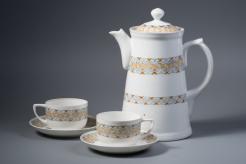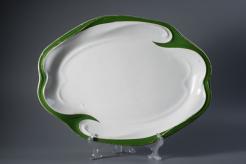




Author: Zigurds Konstants, Dr. habil. chem.
Despite the fact that the Art Nouveau period was short-lived, it was still one of the most prominent phenomena in the architecture and decorative applied arts in Europe at the end of the 19th century and at the beginning of the 20th. Even though it may be considered an international phenomenon, in each country it was still based on local artistic traditions, therefore it oftentimes acquired a distinctly local undertone.
The general characteristics of Art Nouveau are wavy, curved lines and forms, motifs of plants and flowers used in decoration as well as steady, un-nuanced, widely spread colours, separated by pronounced contours or foggy, hazy transitions. Art Nouveau expresses excitement about everything that is flowing, asymmetrical, vertical, slender, transparent, bright, pale, cool, and is made in reserved tints, refines the senses and whose content is rich in symbolism.
The distance of time allows us to appreciate that Art Nouveau was a movement of restoration, an uprising against blind copying of past styles, and search for new forms which complied with the spirit of the period. This affected almost all fields of arts, as well as industrial art and ceramics in particular (including porcelain and faience), glass, textiles, jewellery. They relied on the principle that machines were a new creative art toll, which made decorative applied arts accessible to the masses.
The economic boom and the geopolitical situation of Riga at the end of the 19th century, and at the beginning of the 20th century contributed to the growth of a rich social class, increasing their purchasing power not only for the necessary products, but also for the purchase of fashion products. Since Art Nouveau most distinctly manifested itself in daily life – in the design of articles, interiors, and clothes (naturally, also architecture, books and graphic design), porcelain and faience were no exception. Rigans brought them from their travels or received them as gifts, therefore the majority of preserved articles in museums and private collections are of a variety of origin, and they may be associated as an undivided stylistic set characteristic of that period. However, more permanent traces of Art Nouveau, and not incidental at that, were left by the producers of porcelain and faience (including half-faience) in Riga.
Within this time frame there was no purposeful artistic management in the form of china and its decoration. Neither was market research carried out regarding product demand; however trustees of producing factories and painting workshops constantly followed their competitors and each new item, which was being sold, and provoked either excitement or criticism. Since no copyrights were enforced at that time and no bans existed, outright copying and replication was one of the most common ways, which allowed for a quick and effortless overflow of very similar articles in the European market.
Another characteristic paradigm should be mentioned here. Copying in its internal conviction and thinking was considered an asset. It was not considered an artistic theft, but a testament to the ability to copy, and make something as well as it had been done by someone else. We have to understand that this trend continued to persist in the Riga Porcelain Factory (and not just in Riga) up until the Second World War. The peculiar way of thinking and resulting actions was enforced by initial porcelain decoration handiwork, which in essence required exquisite copying or at least imitation skills. Only the introduction of various mechanical production designs and quality improvement shifted the emphasis from handiwork production to artistic copyrights. However, this is a totally different and no less broad theme that needs to be addressed separately.
More information will be available in the virtual exhibition, which will be established till April 2016.